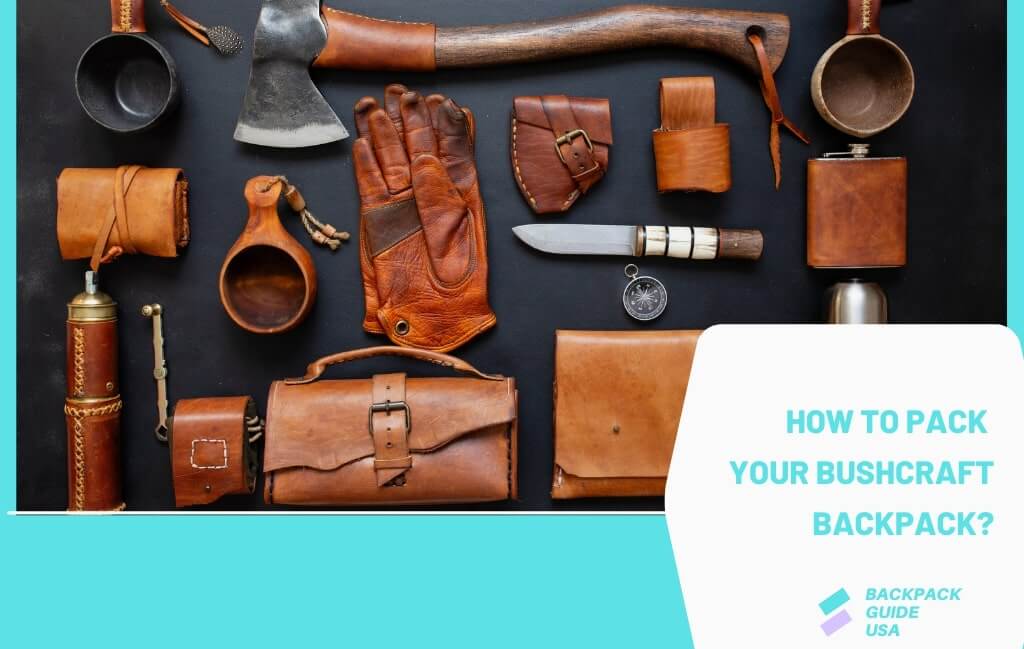How to Pack Your Bushcraft Backpack? 10 Effective Ways

Bushcraft is all about efficiency when it comes to packing and preparing camping gear for your trip, so before you head off on an expedition be sure to pack your backpack in a way that will make life easier later on!
Your main priorities should be safety, warmth and comfort because even the most experienced bushcrafter can get into trouble, especially when traveling alone! Here are some tips which we recommend following:
Step by step guide: How to Pack Your Bushcraft Backpack
What follows below is not an exact science! It never can be. Take it as a rough guide to get you started on the path of traveling lightly.
There will be adjustments along the way, but your experience should dictate what those adjustments are. Do remember, always err on the side of caution when deciding what kit to bring with you and what to leave behind.
First, before you start packing your backpack, take a few minutes and think about the trip you are taking – what environment will you be in? What is the temperature likely to be like? How long do you intend to stay out for? (the longer you stay out for, the more necessary shelter becomes)
Are you traveling with other people? These are just a few of the questions to ask yourself before you begin. You’ll want to consider how heavy your pack is going to be and what provisions you need, but this will largely depend on where you’re traveling and who with whom.
Whatever outdoor environment it is that you find yourself in, there are some things that you will always need. Follow the ten basic steps below to make sure you don’t forget anything…
1) Comfort first!
What’s the point of having a ton of equipment with you if you don’t have enough space on your back?
That’s why we recommend placing heavy items like camping cookware and weapons either at the top or bottom of your bushcraft backpack.
This makes them easier to grab when needed and it also keeps them from shifting around inside your bag which could cause you some problems later on.
2) Equip yourself with a first aid kit!
Having a first aid kit with you is not only recommended but required essentials for bushcraft! That’s why we recommend that you either buy one or make one if possible, packing it in the part of your backpack where smaller objects go.
This makes sure that nothing shifts around and accidentally spills out causing trouble for everyone else. Always keep in mind that just because you’re going camping doesn’t mean that you won’t get hurt!
3) Keep all small items at hand…
Smaller items like medications, toiletries, matches, etc. are best kept close by so they can be easily accessed.
Look for smaller compartments in your pack which will best fit them and of course, look after those small objects so you don’t lose anything important!
4) …but not too close!
Just because we said that smaller objects should be kept closest to you doesn’t mean that they should be packed tight against your back!
Remember that a backpack isn’t just one big pocket, it’s actually more like several little pockets all connected together, so if an item is kept too close to another one of a different shape or size, they might bump into each other causing trouble later on.
This can damage both items or even cause larger cracks in the material, resulting in loss of belongings. Always try to keep items as organized as possible and remember, less is more!
5) …And pack those clothes accordingly!
It’s also a good idea to keep your clothing close by because you never know when you might need to stop and change it into something warm or dry.
So the best way to make sure that your backpack has room for all of this is through the way in which you organize clothes inside of it.
Start off by making separate piles with socks, underwear, shirts, etc. based on what they are and where they would be most comfortable (e.g.: clothing made out of cotton goes near the bottom and puffy jackets go towards the top).
After all, it wouldn’t be very comfortable to wear cotton clothing if it’s cold out and vice-versa!
6) Make sure that you have sufficient food!
You never know when the weather will turn bad, so it’s always a good idea to be prepared for anything. That’s why many backpackers prefer bringing along emergency rations of food in case they get stuck or delayed somewhere.
This is especially common with survival experts during their expeditions, and if you’re going on one too, we recommend adding some extra canned goods or MREs (Meals Ready-to-Eat) to your bag before leaving.
It won’t take up much room and even if you don’t need them, they could come in handy for someone else!
7) Don’t forget about light sources either…
In addition to having plenty of food on hand, you can never forget about having a method for lighting your way in the dark.
Whether it’s a flashlight, headlamp or some other tool for creating light, make sure that there’s one inside of your pack just in case you need it later on!
8) What about safety first?
Since we’re talking about safety here are a few tips which every backpacker should follow: don’t go out into the woods alone, pay attention to any warning signs and do not venture off marked trails!
Nature (especially in places such as forests) is unpredictable so always stay alert at all times! It would be even better if you could bring along someone else who knows their way around but if by chance you are traveling alone then make sure to be extra careful.
9) Pack your rain gear!
Because we all know that there’s always a chance of rain when going camping, it would be best to bring along an umbrella or some kind of raincoat for situations such as this.
It’s not recommended to go out in the woods without protection from this weather because contrary to popular belief… water is actually heavier than air!
So if you see yourself getting soaked then try turning around and finding shelter or better yet, head home before things get worse!
10) Don’t forget about staying warm at night too!
Last but certainly not least is something which will keep you nice and cozy at night – blankets or sleeping bags depending on the time of year.
If you’re planning on camping out in cooler weather, bring along a sleeping bag and some warm blankets. Again, remember that weight is the enemy here, so try to stick with only a few at most!
Last Few Words…
All of this being said, if you’re still unsure about what to pack for your next camping trip or don’t know where to start there are plenty of other articles which can be read on the subject.
In addition to these guidelines above there are also tips about outdoor clothing, hiking gear and footwear too (which all play a part when it comes to packing).
 John
JohnI am John, an outdoor gear staff expertise with tons of practical knowledge. My favorite hobby is moving around the world and adventurous in all the parts of the earth. I have been a worldwide traveler for over 10 years now with no sign of slowing down. I’m happily espoused and residing with my kids in California.
Junyuan BagsTen articles before and after
21 Bushcraft Essentials: Must have and Optional
12 Engineering Student Essentials: You'll Never Guess What's Number One
What Engineers Need to Know Before Going to Law School? | Backpack Guide USA
12 Law School Must Haves: A Handy & Practical Guide | Backpack Guide USA
What to Do The Summer Before Law School? (Must Read) | Backpack Guide USA
15 Bushcraft Camping Gear: Every Traveler Should Carry
Traveling Music Producer: Don't miss this 7 studio equipment!
Best Backpack For Rucking 2021 ( Review & Buying Guides)
10 Music Production Equipment for Beginners: Must Have




 Mobile/What's App/Wechat
Mobile/What's App/Wechat E-Mail
E-Mail ADD
ADD




